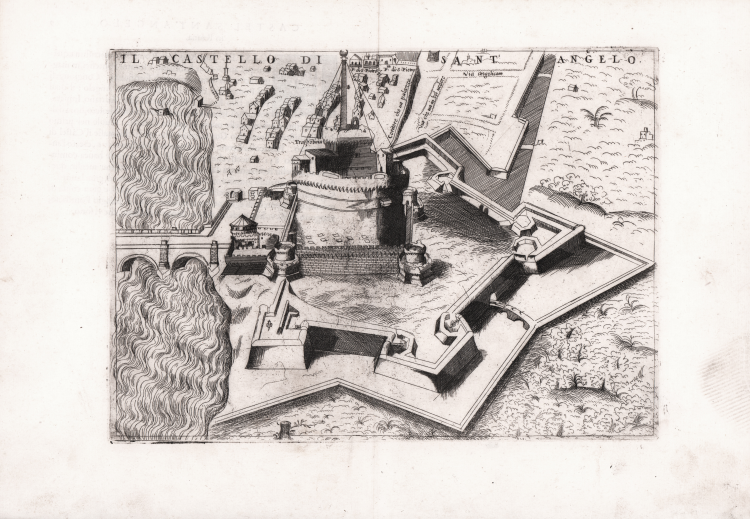



| Reference: | s30711 |
| Author | Paolo FORLANI |
| Year: | 1567 ca. |
| Zone: | Castel Sant'Angelo |
| Printed: | Venice |
| Measures: | 287 x 205 mm |


| Reference: | s30711 |
| Author | Paolo FORLANI |
| Year: | 1567 ca. |
| Zone: | Castel Sant'Angelo |
| Printed: | Venice |
| Measures: | 287 x 205 mm |
Bird's eye-view of the S. Angelo castle, inspired by the work of Giulio de Musi, the very first document of the show from the new outer wall of pentagonal fortification built by Pius IV, equipped with a moat and bastions in the "ace of spades ". For this project, Pope Pio IV, in 1561 was entrusted to the military architect Francesco Laparelli ( 1521-1570), whose fame is mainly linked to the project of founding of the city and fortifications of Valletta, Malta. In addition to the construction of new fortification walls of Hadrian, the draft Laparelli also provided for the planning of a new town, which the pope will take the name of Borgo Pio, and the opening of Porta Angelica .
First published in the Paolo Forlani "Il primo libro delle citta, et fortezze principali del mondo", this example is taken from De’ disegni delle più illustri città et fortezze del mondo, printed by Bolognino Zaltieri in 1569.
Ballino's work is a reissue of the plates of Forlani and Domenico Zenoi; nevertheless it is also the first attempt to realize a complete work completed with text and index.
Copper engraving, wide margins, very in good conditions.
Paolo FORLANI (Attivo a Venezia seconda metà del XVI secolo)
|
Paolo Forlani, a native of Verona, opened his own chalcographic workshop in Venice, Al segno del pozzo, in 1560, as reflected in some of his works. From 1566 he was active in Merzaria al segno della colonna and from 1569 in Merzaria al segno della nave. Forlani had business relationships with the major publishers of cartographic material of the time, among them Antonio Lafreri, the Bertelli family, and others. In addition to being a talented engraver, he was also quick to execute, a quality that enabled him to work for different publishers at the same time, and to execute a large amount of work. Woodward attributes about one hundred works to Forlani, most of which, however, are unsigned. Between 1560 and 1567, Forlani collaborated with Ferrando Bertelli, for whom he engraved about ten copperplates, with Camocio, Bolognino Zaltieri, and with Claudio Duchetti, for whom he engraved some maps. For his professional activity, however, the collaboration with Giacomo Gastaldi, for whom he engraved thirteen maps, was very important and valuable. In 1567 Forlani published and traded his work Il primo libro delle città et fortezze principali del mondo, whose branches later passed to Bolognino Zaltieri. It is likely that Forlani died during the plague that spread through Venice from 1575.
|
Paolo FORLANI (Attivo a Venezia seconda metà del XVI secolo)
|
Paolo Forlani, a native of Verona, opened his own chalcographic workshop in Venice, Al segno del pozzo, in 1560, as reflected in some of his works. From 1566 he was active in Merzaria al segno della colonna and from 1569 in Merzaria al segno della nave. Forlani had business relationships with the major publishers of cartographic material of the time, among them Antonio Lafreri, the Bertelli family, and others. In addition to being a talented engraver, he was also quick to execute, a quality that enabled him to work for different publishers at the same time, and to execute a large amount of work. Woodward attributes about one hundred works to Forlani, most of which, however, are unsigned. Between 1560 and 1567, Forlani collaborated with Ferrando Bertelli, for whom he engraved about ten copperplates, with Camocio, Bolognino Zaltieri, and with Claudio Duchetti, for whom he engraved some maps. For his professional activity, however, the collaboration with Giacomo Gastaldi, for whom he engraved thirteen maps, was very important and valuable. In 1567 Forlani published and traded his work Il primo libro delle città et fortezze principali del mondo, whose branches later passed to Bolognino Zaltieri. It is likely that Forlani died during the plague that spread through Venice from 1575.
|